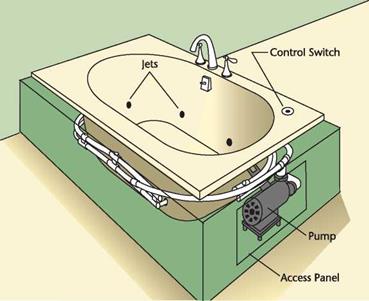As you examine the plumbing in the bathroom you are remodeling, you may notice that current local code requirements for the size, type, and/or height of plumbing components may require a few structural changes. For example, codes set a minimum diameter for stack and vent pipes in relation to the number of fixtures installed. If the home is quite old, a careful examination may find that the current configuration of pipes does not meet these codes, so you must decide what it will take to make the necessary changes. There is also approximately a 5-foot (1.5-m) limit for relocating some fixtures before a new vent needs to be added.
Newer code requirements could also impact how some bathroom fixtures work with older plumbing systems. For example, if you are remodeling a bathroom in an older home, you may encounter
|

problems with the new 1.6-gallon (6 liter) low-flush toilet fixtures. Older waste pipes may be made of cast iron, which has a rougher interior surface than the present plastic pipes, and this could lead to back-ups and clogs. In this case, a power-assisted flush may be needed if new waste pipes are not installed.
Following are other waste/vent considerations:
• If you are remodeling a bathroom, check to see if the new fixtures can make use of existing vent stacks and drains. If not, these could be costly to move because they may require major structural changes.
• High-volume showers need enlarged drain lines.
• Be aware that changes in fixtures may require changes in the drain size or location. For example, the drain line size requirement may change if you replace a tub with a shower. In other cases, fixtures may be able to share a drain line, such as two lavatories. When replacing old fixtures, it would be best if you could select a new fixture that would use the same drain location as the previous fixture to eliminate the need to relocate the drain. As an example, showers come with a drain opening at either the center or side. Select a new shower that will be compatible with the existing drain.
• When replacing an old freestanding toilet, drain location specifications on the new fixtures may be different. Many older toilets were mounted such that the distance from the center of the drain outlet to the stud wall was 10, 12, or 14 inches (250, 300 or 350 mm) . Newer toilets are mounted with the center of the drain 12 inches (300 mm) from the wall. An offset flange may be used to adjust for this difference if it is 1 ‘h inches (37 mm) or less.
• If you are including a steam unit somewhere in the bathroom, be sure the contractor has planned a drainpipe for the steam generator.
• One other consideration in the waste/drain system, for clients who are not connected to a municipal waste system, is the septic tank. Septic tanks are sized based on the house and family size. If your client plans to install a whirlpool, full body-spray shower, or other high water-use fixtures that will place an increased amount of water into the waste system, you will need to check the capacity of the septic system to make sure it can handle the additional water. It may be that you will need to have the client add a larger septic tank, or additional septic tank, to accommodate the extra water. If too much water flows through a septic tank, the system cannot
adequately deal with the waste products, leading to a breakdown of the septic system and environmental consequences.



